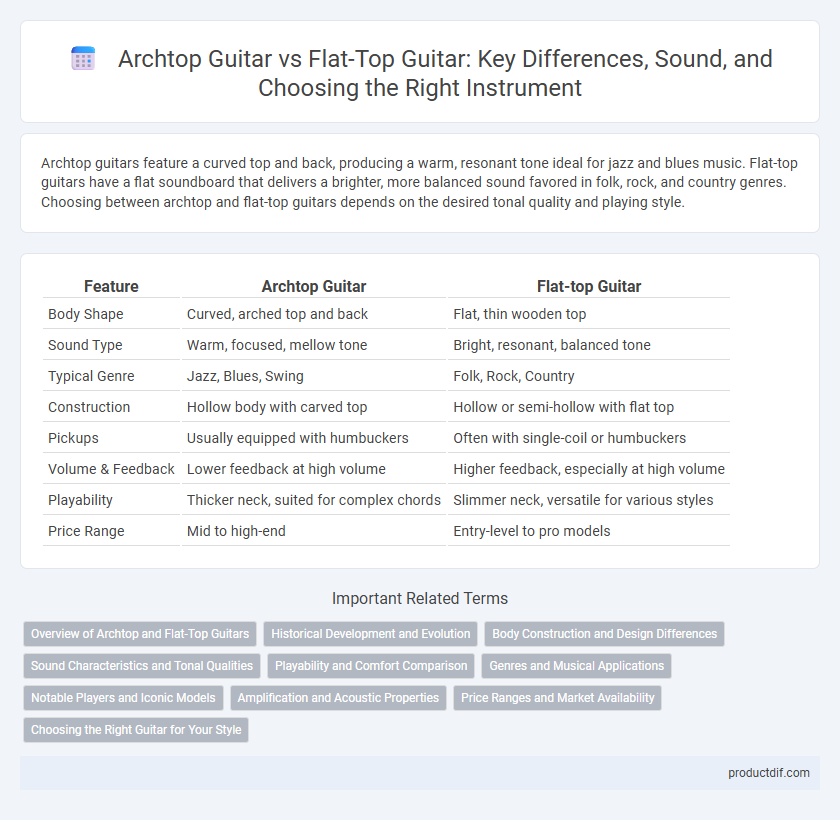Archtop guitars feature a curved top and back, producing a warm, resonant tone ideal for jazz and blues music. Flat-top guitars have a flat soundboard that delivers a brighter, more balanced sound favored in folk, rock, and country genres. Choosing between archtop and flat-top guitars depends on the desired tonal quality and playing style.
Table of Comparison
| Feature | Archtop Guitar | Flat-top Guitar |
|---|---|---|
| Body Shape | Curved, arched top and back | Flat, thin wooden top |
| Sound Type | Warm, focused, mellow tone | Bright, resonant, balanced tone |
| Typical Genre | Jazz, Blues, Swing | Folk, Rock, Country |
| Construction | Hollow body with carved top | Hollow or semi-hollow with flat top |
| Pickups | Usually equipped with humbuckers | Often with single-coil or humbuckers |
| Volume & Feedback | Lower feedback at high volume | Higher feedback, especially at high volume |
| Playability | Thicker neck, suited for complex chords | Slimmer neck, versatile for various styles |
| Price Range | Mid to high-end | Entry-level to pro models |
Overview of Archtop and Flat-Top Guitars
Archtop guitars feature a curved, carved top made from solid wood, producing a warm, focused tone ideal for jazz and blues genres. Flat-top guitars have a flat soundboard, commonly constructed with laminated woods, delivering a bright, resonant sound favored in folk, rock, and country music. Both instruments offer distinct tonal characteristics influenced by body shape and construction, catering to different musical styles and playing techniques.
Historical Development and Evolution
Archtop guitars originated in the early 20th century, influenced by violin construction techniques to produce a distinct curved top and f-holes, enhancing projection and tonal clarity for jazz musicians. Flat-top guitars evolved alongside bluegrass and folk genres, featuring a flat soundboard and round sound hole that emphasized volume and warmth suitable for acoustic performances. The evolution of both designs reflects their adaptation to specific musical styles, with archtops favoring amplified settings and flat-tops excelling in unplugged environments.
Body Construction and Design Differences
Archtop guitars feature a carved, arched top and back made typically from solid wood, providing enhanced resonance and a focused, warm tone ideal for jazz and blues. Flat-top guitars have a flat soundboard constructed through bracing patterns like X-bracing, which offers greater volume and brightness favored in folk, country, and rock genres. The hollow body design of archtops contrasts with the often thicker, bulkier flat-top bodies, influencing both sound projection and playability characteristics.
Sound Characteristics and Tonal Qualities
Archtop guitars produce a warm, resonant sound with pronounced midrange frequencies, making them ideal for jazz and blues genres. Flat-top guitars deliver a brighter, more balanced tone with stronger bass response and greater projection, suited for a variety of styles including folk and rock. The carved, arched top of archtops enhances sustain and clarity, while the flat-topped design enhances volume and dynamic range.
Playability and Comfort Comparison
Archtop guitars feature a carved, curved top that offers enhanced playability through better string action control and comfortable hand positioning, making them ideal for jazz and complex chord work. Flat-top guitars, with their flat soundboard, provide a wider neck and lower string tension, improving ease of play for strumming and fingerstyle techniques. Both designs impact comfort differently, with archtops favoring precision and flat-tops excelling in versatility for various playing styles.
Genres and Musical Applications
Archtop guitars excel in jazz and blues due to their warm, focused tone and enhanced projection, making them ideal for complex chord voicings and single-note solos. Flat-top guitars are favored in genres like folk, country, and rock, offering a brighter, more resonant sound suited for strumming and rhythmic accompaniment. Musicians select archtop models for smooth, mellow tones in intimate settings, while flat-top guitars deliver versatility and volume for diverse musical applications.
Notable Players and Iconic Models
Archtop guitars are famously associated with jazz legends like Wes Montgomery and Joe Pass, with iconic models such as the Gibson ES-175 and the D'Angelico New Yorker defining the genre's sound. Flat-top guitars, favored by artists like Eric Clapton and Bob Dylan, include iconic models like the Martin D-28 and Gibson J-45, known for their versatility across folk, rock, and blues. The distinct tonal qualities of archtop and flat-top guitars have influenced these players' signature styles and helped establish enduring standards in guitar craftsmanship.
Amplification and Acoustic Properties
Archtop guitars feature a curved top and hollow body designed for enhanced projection and feedback resistance, making them ideal for amplified jazz and blues performances. Flat-top guitars offer greater acoustic volume and a balanced tonal range due to their flat soundboard, excelling in unamplified genres like folk and country. Amplification in archtops benefits from their built-in pickups and reduced feedback, while flat-tops often rely on external microphones or piezo pickups to capture their rich, natural resonance.
Price Ranges and Market Availability
Archtop guitars typically range from $1,000 to over $10,000, with high-end models favored by jazz musicians for their rich tones and limited production yields making them less common in general markets. Flat-top guitars, often more affordable, span from $150 to several thousand dollars, enjoying widespread availability in music stores and broad appeal across genres like folk, rock, and country. Market demand for flat-top guitars remains strong due to their versatility and lower price points, while archtop guitars attract niche buyers willing to invest in craftsmanship and distinctive sound.
Choosing the Right Guitar for Your Style
Archtop guitars feature a curved top and hollow body, producing a warm, resonant tone ideal for jazz and blues styles. Flat-top guitars offer a flat soundboard with a broader tonal range and brighter sound, making them versatile for genres like rock, folk, and country. Selecting between archtop and flat-top guitars depends on your preferred music style, desired sound characteristics, and playability preferences.
Archtop guitar vs Flat-top guitar Infographic

 productdif.com
productdif.com